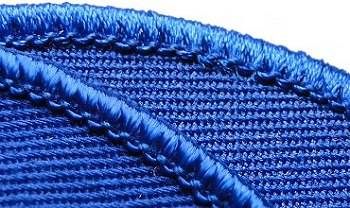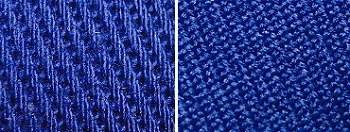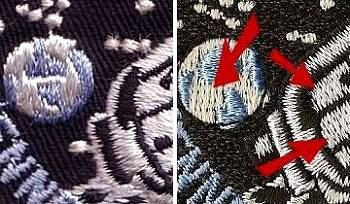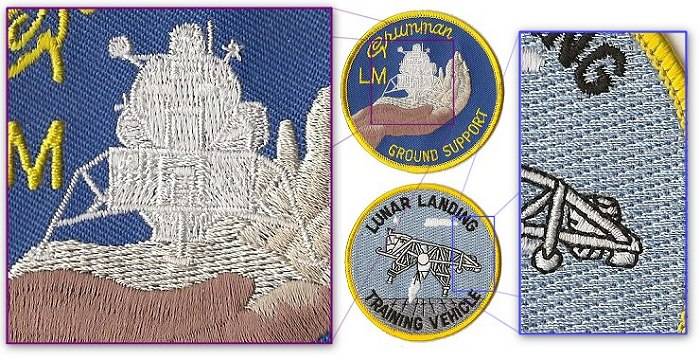Determining the Age of Embroidered Patches
Given that some of the rarer vintage space patches regularly sell for hundreds of dollars it is clearly very important to able differentiate between these original patches and later reproductions, replicas, fantasy patches, or fakes.
A fantasy patch is generally defined as a design that was never originally produced as an embroidered patch. The artwork for these patches are frequently based on vintage decals or vintage artwork, and are occasionally invented from scratch to represent an insignia that might have existed at the time. Replica patches are of course those based on embroidered patches that did exist, but which are generally difficult to find today.
It should be noted that there is nothing intrinsically wrong with creating replica or fantasy patches. The only problem comes when these patches are mistaken by collectors for vintage originals and when collectors then spend significant amounts of money on them without realizing that they are not genuine.
Probably the most notorious replica and fantasy space patches are those that were produced by Randy Hunt (aka 4gator on eBay) from the 1990s to 2007. The reason for their notoriety is the disingenuous way in which these replicas were marketed, with examples being consistently listed for sale on eBay as 'rare' without any mention of the fact they were actually modern replicas or fantasy patches.
These patches were often produced on demand in very small quantities. A collector would contact Randy Hunt asking if he had a particular rare patch and he would tell them he'd get back to them. He would then have perhaps three 'replica' examples produced. One example would be sold to the collector (who would not necessarily be aware that the patch was a replica), one sold on eBay, and one kept by Randy himself.
The fact that these patches often had bare cloth backs and were generally accurate replicas of the original artwork means that the majority of buyers thought they were acquiring a rare vintage original patch. When these patches have found their way back to the market in subsequent years, they have frequently been mistaken for vintage originals and can sell for hundreds of dollars a piece rather than at an appropriate price for a replica.
Since these replicas were often produced in tiny numbers it is not always possible for us to have known examples against which to compare patches for sale. What is needed is a more general methodology for differentiating vintage original patches from modern replicas, which is something I attempt to tackle on this page.
Note that the comments below are primarily concerned with differentiating patches produced during the Mercury, Gemini and Apollo era from those produced after this period, either as later production runs or replicas. Differentiating patches produced around the time of a particular Shuttle mission and one produced some years later is not something I attempt to cover.
Backings
By happy coincidence the cut-off point between the end of the Apollo era (the Apollo-Soyuz Test Project in 1975) and the start of the Shuttle era (the Approach and Landing Tests in 1977) corresponds neatly with the general introduction of wax or plastic backings by NASA's official patch supplier AB Emblem.

As far as I'm aware no space patches were produced in bulk prior to the Shuttle era with plastic or wax coatings on the reverse. Certainly all the known versions of the Apollo-Soyuz Test Project mission patch produced at the time of the mission (1975) had bare cloth backs with one exception - the ASTP initialled crew patches. This limited run of oversize patches produced for the crew appear to be the first plastic backed space patches.
Some manufacturers, such as Lion Brothers, did continue to produce bare cloth back patches in the early Shuttle era but this does not stop us from being able to state that to the best of our knowledge no plastic/wax backed patches were mass- produced prior to the Shuttle era.
What we can conclude from this is that any patch with a plastic or wax coating on the reverse can be said with near certainty to have been produced after the Apollo era. If it is a Mercury, Gemini or Apollo patch then it is likely either a later production run or a replica.
On the other hand, the reverse of the rule does not hold true. A bare cloth back on a patch does not prove that it was made in the pre-Shuttle era. Patches can be made today with bare cloth backs so by itself the presence of a bare cloth back tells us little or nothing about the age of a patch.
The replica patches produced by Randy Hunt are a case in point as they were generally produced with bare cloth backings. So while the presence or absence of coatings on the backs of patches allows us to clearly identify some as later versions it does not provide us a reliable method of identifying modernreplicas.
Twill types
Some patches, including many early examples from the 1960s, have exposed twill backing cloth making up at least part of the design.
This twill has a distinctive appearance with broad parallel raised ridges of rope-like multi-strand threads running across the cloth in a single direction. A cheesecloth like arrangement of single strands angled at an oblique angle to the main pattern is just about visible underneath.
Over the years the cloth used in the embroidery industry has changed, so that the style of twill most commonly used today has a quite different appearance.
The modern twill cloth is formed of a fine grid of overlain intersecting single threads. There are no rope-like multi strand threads.

I have gone through my own vintage patch collection examining every patch from the pre-Shuttle era with exposed twill and the vast majority show the 'vintage' style of twill.
Notable exceptions are the white cloth used in the Apollo 7 crew patch and the backing cloth in the Grumman Snoopy patch (both of which are not twill materials), and the yellow twill used on the Lion Brothers Apollo 1 patch.

I only have a limited number of modern replica and fantasy patches to examine so I cannot say for certain that none show the old twill style but all of those I have examined show the 'modern' style.
What we can conclude from this is that any patch showing the modern style of twill illustrated here is likely to have been produced after the Apollo era. If the design is supposed to be contemporary with the Mercury, Gemini or Apollo era then it is most likely either a later production run, or a modern replica or fantasy patch.
On the other hand, since it may still be possible to source old style twill, the reverse of the rule does not hold true. The appearance of old style twill on a patch does not prove that it was made in the pre-Shuttle era.
This indicator can of course only be applied to those designs that incorporate exposed twill backing but this applies to a fairly significant number of vintage patch designs and helps us weed out quite a few modern reproductions.
Fill-stitch styles
Patches produced in the pre-Shuttle era tended to use a fill-stitch pattern known as the satin stitch. This is effectively just lots of close-set parallel lines of stitches covering the backing cloth.
At some stage in the development of embroidery techniques a new fill-stitch style became widely adopted on embroidered patches which has a distinctly different appearance.
In the example below the modern fill pattern shown on the right looks rather like a fine netting made up of parallel lines of thread intersecting at a shallow angle. When compared with the satin stitch fill shown on the left it can be noted that the modern pattern leaves little gaps between the adjacent rows of stitches that are quite visible. When applied on a larger scale the pattern looks a little like ropes laid side by side running at a shallow angle across the fill area.
 Satin stitch fill on a vintage patch (left) & modern fill on a replica (right)
Satin stitch fill on a vintage patch (left) & modern fill on a replica (right)
In modern computer-aided digitzing a common technique used to fill large areas of a design is to let the software fill a designated area with a set pattern, usually a variant of the 'netting' pattern noted above. This is known as 'complex fill' and the characteristic result is a fill pattern whose angle is fixed relative to the patch as a whole and which makes no attempt to follow the curve or angle of the area itself.
Artists working before the introduction of computer-aided digitzing software would tend to fill such areas using satin stiches angled to follow the edges of the fill area.
I can't say for sure when the complex fill technique or the 'netting' fill pattern came into widespread use but I can say that of all the vintage space patches in my collection that date from the pre-Shuttle era not one patch shows this distinctive fill pattern. On the other hand most modern patches, including many replicas of vintage patches, include at least some fill areas using this style of stitching.
I would propose that any patch showing this 'modern' fill stitch pattern dates from the modern era. If the patch is a Mercury, Gemini or Apollo patch then it is likely either a later production run or a replica/fake.
As with coatings on the backs of patches this rule cannot be applied in reverse. The absence of this modern fill style does not prove that a patch is genuinely vintage, particularly if there are no large fill areas on the design.
In my own replicas I deliberately try to use a satin stitch fill thread pattern in order to match the vintage look of the originals as closely as possible and others may have done the same in the past, either by design or accident. However, the digitizing artists nearly always revert to the modern stitch style by default so despite my best efforts my own replica patches often show at least some areas with this fill pattern.
Although I have been able to examine only a small fraction of Randy Hunt's prodigious output of replicas I can say that the majority of examples that I've seen do show the modern fill style.
Once you get used to spotting this fill style, its presence on rare and supposedly vintage patches looks glaringly out of place and immediately hints at a replica or fake, as shown in the examples below.
Fill-stitch style examples:

I believe both of these patches to be modern replicas and the presence of the distinctive modern fill pattern in both patches is one of the key giveaways.
On the Grumman LM Ground Support patch this fill pattern is clearly visible in the palm of the hand and this is also a classic example of the 'complex fill' technique applied to an irregularly-shaped area.
It's also worth noting that the blue twill background of the Grumman LM Ground Support patch is clearly of the modern style, as described in the earlier section. My conclusion is that both patches are modern replicas.
Ultra-Violet Fluorescence
As far as I know no one has looked before at the application of ultra-violet fluorescence to the dating of embroidered space patches, although the technique is used extensively for identifying counterfeit currency and documents, and in the world of stamp collecting, and since undertaking this study I've found that the technique has already been applied to some other fields of embroidered patch collecting.
In general the strong fluorescence of fabric or thread under ultra-violet light is due to the presence of what are known as optical brightening agents (OBAs) or fluorescent whitening agents which absorb UV light and emit it in the visible spectrum, making fabrics appear both whiter and brighter.
When examined under a UV lightsource (e.g. a handheld UV blacklight lamp) materials impregnated with these agents will fluoresce brightly.
Optical brightening agents began to see widespread use as early as the 1940s, and thus were present in the 1960s and early 1970s when the original Gemini and Apollo space patches were being produced. However, they have only become truly ubiquitous in fabrics, threads, and in fabric detergents in the last few decades.
Application to dating patches
So what use is all this in trying to date embroidered patches? Well, if we assume that the vast majority of replicas of rare Gemini and Apollo-era patches were produced in the last couple of decades (1980s to today) it seems likely that the white thread in these patches will contain significant quanities of optical brightening agent and will therefore fluoresce brightly under UV light.
But what about vintage patches from the pre-Shuttle era? Brightening agents already existed at the time these patches were made so it is possible that they too might fluoresce under UV light.
In the end it seemed to me that the only way to determine if these brightening agents were widely used in embroidered patches at that time would be to examine a broad range of vintage patches under UV light, so this is what I set out to do.
Below is shown a small selection of some of the oldest known space patches. The image shows the patches under normal lighting but if you move the cursor over the image it should switch to show how the patches look under UV light.
You will see that although the lighter areas of thread obviously look lighter under the UV light source they do not fluoresce brightly.
The only notable reaction in some of these vintage patches, apart from the exceptions detailed in the next section, are the glowing borders of certain patches such as the Apollo 8 and 17 Lion Brothers and AB Emblem patches, as shown below.
Detail of Apollo 17 "White Eagle", regular AB Emblem, and Lion Brothers patches under normal light and UV light (rollover) showing border glow.The source of the fluorescence on these borders seems to be a different kind of thread used to anchor the inside, and in some cases the outside edge, of the merrowed border. The border thread itself does not glow.
Sadly I don't own examples of every vintage space patch identified on this site but I have now examined numerous Gemini crew patches, Apollo mission patches, NASA insignias, project patches, recovery patches, and vintage contractor patches under UV light.
My conclusion is that OBA-impregnated threads or fabrics were very rarely used in those embroidered space patches produced in the 1960s and early 1970s.
There are a few exceptions, which I will detail in the next section, but it's safe to say that the vast majority of vintage patches from this period exhibit no significant fluorescence under UV light.
Noteworthy exceptions
Before going any further it is interesting to note the exceptions I have identified in my own collection - patches that I believe to be vintage but which nevertheless show marked fluorescence under UV light.
The oldest patch in my collection to exhibit fluorescence is the Apollo 7 crew patch. This is an unusual patch in that it is partially embroidered on white cloth, not twill as is more commonly the case, and the exposed white cloth fluoresces strongly under UV light, implying that this material was impregnated with brightening agents.
Another vintage patch that shows strong fluorescence is the oval version of the Snoopy patch commonly found in Grumman patch collections. Like the Apollo 7 crew patch this design is partially embroidered on a white cloth (not twill) that fluoresces under UV light.
The exposed yellow twill in the Lion Brothers Apollo 1 patch also fluoresces brightly under UV light but in all these cases it is the backing material rather than the thread which reacts.
The earliest patch I could find where the thread appears to be impregnated with brightening agents is the Apollo 11 Voyager Emblem patch. The white thread in this design fluoresces strongly, as can be seen in the lineup of vintage Apollo 11 patches below.
This privately-commissioned Apollo 11 patch is the only space patch known to have been produced by Voyager Emblems. It may be the case that this company adopted optically-brightened thread some years before the other embroidery companies. Whatever the explanation, this remains the only pre-Shuttle space patch I have identified so far that uses fluorescing thread in the design.
In any case these patches represent noteworthy exceptions out of well over a hundred patches manufactured in the 1960s and early 1970s which I was able to examine under UV light.
However, there is a complication to this story, which is that some Lion Brothers Apollo patches show UV fluorescence in their thread. Since Lion Brothers Apollo patches are all considered to be vintage what does this mean?
In fact it has always been accepted that Lion Brothers continued to produce their Apollo mission patches until the early to mid 1980s, before dropping production around the time they switched to plastic backings on their Shuttle patches.
Those Lion Brothers patches which show marked fluorescence tend to be very fresh and clean in appearance and are highly stiffended with starch. It seems reasonable to assume that these patches are late examples produced in the early to mid 1980s, and that by this time fabrics and threads impregnanted with optical brightening agents had been adopted by Lion Brothers.
False positives
There is one final source of confusion and 'false positive' UV fluorescence. As has been mentioned previously, modern fabric detergents contain significant quanities of optical brightening agents which are designed to be absorbed by clothing during the washing process, making fabric look brighter and whites look 'whiter'.
This of course means that those vintage patches which have been washed, either because they were sewn to clothing that was washed or because someone decided to wash a soiled patch, may show some trace of UV fluorescence as a result.
This could explain why a particular vintage patch shows unexpected UV fluorescence, but there is a danger that this excuse could be used to explain away the fluoresence of what is really a modern replica as simply the result of washing.
In reality, washed patches are relatively uncommon. More importantly, it is usually fairly obvious from the appearance of a patch whether or not it has been through a washing cycle.
In the case of a suspected modern replica, washing should only be entertained as an explanation for UV flouorescence if the patch shows clear signs of having been washed.
Modern Replicas
From my observations so far it seems that virtually all modern replicas show extremely bright fluorescence, at least where white thread is used in the design.
For example, all sixteen of my own replica patches show very strong fluorescence from the white thread areas. Put one of my replica LTA-8 patches alongside the vintage original patch and I like to think they look pretty similar. However, if you observe them under UV blacklight the replica is 'glaringly' obvious (which in my opinion is a good thing).
As mentioned in the introduction the 'replica' patches that are most commonly mistaken for rare vintage patches are those that were produced by Randy Hunt.
Unfortunately, the fact that these patches are so frequently mistaken for rare vintage originals means that it is prohibitively expensive to acquire examples in order to be able to examine them. This in turn means that I am unable to say for sure whether Randy Hunt's patches react to UV light.
However, since those replica patches that I do own all react to UV light, I think it is safe to assume that the vast majority of modern replica patches will show UV fluorescence, at least where the designs include some areas of white thread.
UV fluorescence in summary
Despite the fact that a very small number of known vintage pre-Shuttle space patches do show some UV fluorescence, the fact remains that the vast majority do not.
If we assume that the vast majority of modern replicas and fantasy patches produced in the last couple of decades do show marked UV fluorescence then examination under UV light can indeed be a useful tool in helping to identify whether a mystery patch is more likely to be a modern replica than a vintage original.
It's important to note that although UV fluorescing thread appears to be widely used today, it did not start being widely used immediately following the Apollo era. Many patches from the late 1970s and even the 1980s will show no reaction to UV blacklight.
This means that although a reactive patch is likely to be modern, a non-reactive patch does not necessarily date from the Apollo era.
Obviously as a technique for identifying suspected modern replica patches this method has two major limitations - 1) you need to have access to a blacklight UV source, and 2) you need to have the patch in question in your possession.
This makes it more a tool for a collector to validate patches in their collection rather than a means to evaluate patches before purchase but once a patch is verified as a probable replica in this way that information can be shared with other collectors, allowing other people to avoid expensive mistakes.
Conclusions
There is still no foolproof test which allows us to identify vintage patches but using the information above it should be possible at least to spot the majority of modern replicas.
The first important point to remember is that the absence of a plastic coating on the reverse of a mystery patch tells us nothing about its age, other than the fact that it could be vintage.
If you are able to examine the front of a patch in some detail it may be possible to spot the use of the modern full stitch style detailed above, which in my opinion is a clear sign of a modern patch.
If you have a mystery patch in your collection and are not sure whether it is a vintage original or a modern replica then examination under UV light may be worthwhile.
If a patch which supposedly dates from the 1960s or early 1970s fluoresces brightly under UV light and shows no visible sign of having been washed then the odds are strongly in favour of it being a modern replica.
If the patch also exhibits the modern fill stitch style then I believe you can be virtually certain it is a replica.
Warning: Ultra-Violet Light
Although the long wave ultra-violet light produced by 'black light' bulbs is generally weak and much less harmful than shortwave UV, exposure of bare skin to this light should be minimized and protective eye wear should be worn when using such a light source.